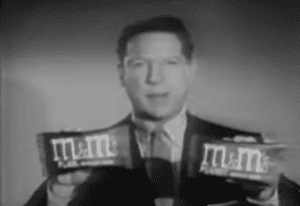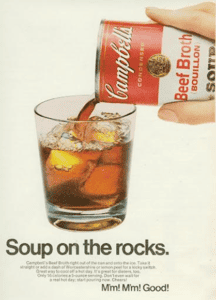The best ideas are obvious when you think about them
The principle of Unique Selling Proposition (USP) was conceived by a fella by the name of Rosser Reeves. Born in 1910, Reeves began his career at the advertising agency Ted Bates & Co. in the 1940s.
It’s hard to conceive that the USP (the idea that advertising campaigns must highlight a distinct and compelling feature of a product that sets it apart from its competition), was once a new way of thinking.
But it really was a complete departure from the more artistic and less direct methods of the time. Reeves argued that consumers were less swayed by creative flair and more by clear, repeated messages emphasising a product’s unique benefits.
And the principle remains at the heart of most advertising thinking today.
Does a USP really need to be unique?
One of the greatest early examples of this (now fairly common) approach is the M&M’s “Melts in your mouth, not in your hands” campaign, which was created by New York advertising agency DDB, in 1954. It’s a classic example of how a simple, clear, and memorable message can effectively communicate a brand’s key attribute and resonate with consumers for decades.
It zeroes in on just one thing, the one thing that resonates with the consumer, the one thing that makes it different and identifiable.
Of course, at the time it was a USP because it was unique. The clue’s in the name.
But does a USP have to be unique?
Well, by definition, yes.
But you could argue that the product itself doesn’t have to be uniquely different.
The reality is that many successful USPs are crafted from unique ways of delivering, presenting, or marketing a product or service that may not be fundamentally different from competitors.
The effectiveness of a USP lies in its ability to create a perception of uniqueness and value in the consumer’s mind, whether it’s based on an actual product feature or a unique aspect of the product offering.
Take Avis.
In 1962 it was second in the market to Hertz. The company didn’t have a USP.
The service it offered was pretty similar to Hertz – it hired out similar cars, from all the same locations at roughly the same prices.
Avis’s service was (arguably) better, but not noticeably better in any specific respect. Not enough to hang their hat on.
Then along comes advertising agency DDB (again), and it launches the “We’re only No. 2, so we try harder” campaign.
Without having any tangible USP, Avis delivered a compelling proposition. It’s easy to believe that the number 2 in the market is the underdog. It tries harder, so you get better service. It’s easy for our brains to connect the dots.
The only USP in sight was Avis’s market position.
Nothing to do with the product or the service. It offered nothing tangible.
The Avis success story is a testament to the power of positioning in marketing. It’s all about perception. It’s not just about what you sell; it’s about how you sell it and how you make your customers feel about what they’re buying.
And it’s a critical lesson for marketing professionals and business leaders — understanding that uniqueness doesn’t have to be about tangible product differences.
Of course, identifiable differences are helpful. If you genuinely have a USP, and it’s something that matters to the customer, then you should use it.
So how do you go about doing that?
OK, so delivering marketing communications that utilises a USP relies (at least initially) on you knowing what your USP is and on you understanding whether or not it’s a strong one.
A USP is not strong if:
- You could swap out your brand name for a competitor and it could work equally well, or;
- It’s not something customers care about – just because you have a ‘cool’ and unique product feature, does not automatically mean you’re onto a winner.
Once you’ve got something you can believe in, then you need to find the most compelling way to communicate the idea. According to Rosser Reeves, your advertising needs to deliver on these three things:
- Each advertisement must make a proposition to the consumer.
Not just words, not just product puffery, not just show-window advertising. Each advertisement must say to each reader: “Buy this product, and you will get this specific benefit”. A clear, simple and single-minded idea. Couldn’t agree more. - The proposition must be one that the competition either cannot, or does not, offer.
It must be unique – either a uniqueness of the brand or a claim not otherwise made in that particular field of advertising. That’s the USP bit. See. It doesn’t have to be a unique benefit, but it must be positioned in a unique way. - The proposition must be so strong that it can move the mass of millions.
Your advertisements should pull over a large number of new customers to your product. Well sure, that’s what we all want. Obviously, if your target market isn’t millions, you can reduce the number accordingly. But the point is, it should be strong enough to make your audience take notice and change their behaviours.
So how do you know if you’ve got a proposition that delivers? How do you know if you’ve got a big idea?
David Ogilvy, another giant of the advertising industry suggested that you should ask yourself:
- Did it make me gasp when I first saw it?
- Do I wish I had thought of it myself?
- Is it unique?
- Does it fit the strategy to perfection?
- Could it be used for 30 years?
Clearly, that’s setting a high bar. But we should always aim high – otherwise, what’s the point?
We advertise to make our product successful, so it’s worth investing the time to find our USP, whether that’s based on a feature, a benefit or an angle no-one has tried before.
And it’s also worth making the following point – another important Rosser Reeves rule:
If you’re lucky enough to write a good advertisement, repeat it until it stops selling.
According to Reeves, research shows that the readership of an advertisement does not decline when it is run several times in the same magazine.
Readership remains at the same level throughout at least four repetitions. “You aren’t advertising to a standing army; you are advertising to a moving parade.”
In fact, there’s an established idea that it takes 20 exposures to an ad before the customer is ready to make a purchase. It takes time for a message to be recognised, sink in and change behaviour. It works like this:
The first time you see a brand message, you hardly notice it and are likely to ignore it.
The second, third, and fourth time you see it, the message is put on your radar.
The fifth time you see it, you take the time to actually stop and read it, and you’re able to recognise it.
The sixth, seventh, and eighth time you see it, it may start to annoy you a little bit.
The ninth time you see it, you start to think there may be something to it.
The tenth, eleventh, and twelfth time you see it, you start to casually think about it.
The thirteenth time you see it, the product or service becomes worth something to you.
The fourteenth to nineteenth time you see it, you slowly start to consider buying or saving up for the product or service.
The twentieth time you see it, you’re fully convinced to make a purchase.
The more times a lead is exposed to your message, the more likely they are to convert. If you change your USP/proposition too often, you’ll actually damage brand recognition, which in turn, will adversely affect sales.
So, give your USP time to work, and accept it’s not going to deliver immediate gratification.
But when you’ve got a USP that works, don’t change it. Be consistent.
Being consistent doesn’t means you have to be boring
Keeping your USP consistent doesn’t preclude you from changing advertising executions to keep them fresh. The point is, the underlying message should remain the same, but this can be presented in new ways.
Take VW Polo.
Small but tough.
Not really a USP, when you think about it, but they found a positioning that was believable, and that no competitor was presenting to the market.
So they took it and ran with it for years and years. And years.
Different execution after different execution. All communicating the same core idea.
A dozen police officers taking cover behind a VW Polo.
An elephant straddling a VW Polo.
King Kong hurting his foot on a VW Polo.
The point is you can create different ads, both in design and copy, but they must all reinforce your core USP.
Tell the same story, over and over. Don’t change your story.
Changing a story has the same effect as stopping the money. A competitor can out-gun you with a less interesting campaign if they don’t change their story.
If you’ve got a great idea that’s working, and it’s simple enough that it can spawn multiple executions, then you’re onto a winner.
A great campaign won’t wear itself out.
The product may become outmoded, but if it’s done right, not the campaign.
And finally (I’ve said this before, and I’ll say it again)
Remember that we live in an overcommunicated society. We’re exposed to upwards of 5,000 brand messages a day.
According to Reeves, “there is a finite limit to what a consumer can remember about 30,000 advertised brands. It’s as if the consumer carries a small box in his head for a given product category. This box is limited either by his inability to remember or his lack of interest.”
So, as your USP becomes increasingly better known, the USPs of your competitors fade from people’s minds.
That’s really important to realise. A USP combined with consistency in your advertising delivers genuine competitive advantage.
Today, there are over 100,000 brands advertising at any one time.
Rosser Reeves’ ideas on advertising are more important now than they’ve ever been.



